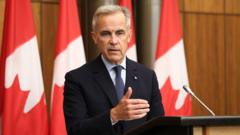Will Canada Eliminate Retaliatory Tariffs on the US?

On 1 September, Canada will adjust its retaliatory tariffs on US goods, dropping levies on products compliant with the US-Mexico-Canada free trade agreement (USMCA), while maintaining high tariffs on autos, steel, and aluminium. This shift follows a conversation between Prime Minister Mark Carney and President Donald Trump, highlighting ongoing trade negotiations and the complexities of international relations.
Last updated: 25 October 2023 (BST)
Understanding the Tariff Changes
Tariffs are taxes imposed by governments on imported goods. In this case, Canada had previously enacted a 25% tariff on approximately C$30 billion (£16 billion; $21.7 billion) of US goods in response to US tariffs on Canadian products. The decision to reduce these tariffs signals a potential thawing of tensions in trade negotiations between the two nations.
Key Takeaways
- Canada will drop tariffs on US goods compliant with the USMCA.
- High tariffs will remain on autos, steel, and aluminium.
- The tariff changes take effect on 1 September.
- Polling indicates strong Canadian support for retaliatory measures.
- The conversation between Carney and Trump marks a renewed focus on trade discussions.
Context of the Tariff Dispute
The current trade tensions began when the United States imposed tariffs on Canadian steel and aluminium, citing national security concerns. This move was met with immediate backlash from Canada, which viewed the tariffs as unjust and retaliatory in nature. Canada’s tariffs on US products included a wide range of items, from orange juice to washing machines, reflecting the extensive trade relationship between the two countries.
As of August, US tariffs stood at 35% on goods not compliant with the existing trade agreements. Carney's announcement to match the US by dropping tariffs on compliant goods aims to restore free trade for the majority of products exchanged between the US and Canada, a crucial aspect of their economic relationship.
Political Implications
Prime Minister Mark Carney's government, which came to power in April, has adopted a robust negotiating stance, described as an “elbows up” approach. This term is derived from hockey, symbolising a combative and assertive style in negotiations. Carney's stance has garnered public support in Canada, particularly among those who favour a strong response to US trade policies.
The White House welcomed Canada’s decision, labelling it “long overdue.” This indicates a desire from the US administration to move forward in trade discussions, which have been fraught with tension since Trump’s return to the presidency in January. The US president has pursued aggressive trade policies, imposing tariffs on various countries and threatening further increases as part of his strategy to negotiate favourable trade agreements.
The Impact on Trade Relations
The decision to drop certain tariffs is significant for both nations. With trade accounting for a substantial portion of both countries' economies, especially in sectors like agriculture and manufacturing, any changes in tariff policies can have widespread effects. The restoration of free trade for compliant goods is expected to benefit businesses and consumers on both sides of the border.
Future Prospects for US-Canada Trade
Looking ahead, the future of US-Canada trade will depend on several factors, including the ongoing negotiations between the two countries. Both governments have expressed intentions to continue discussions on trade and national security issues. It remains to be seen how these talks will evolve and whether further agreements can be reached to enhance trade relations.
As the global economic landscape continues to shift, both countries will need to navigate their trade policies carefully to maintain competitiveness. This adjustment in tariffs could be a pivotal moment in redefining the trade relationship between Canada and the US, especially as global markets respond to changes in tariff structures.
Conclusion
The decision by Canada to drop some retaliatory tariffs marks a significant development in the ongoing trade saga with the United States. While this move is expected to facilitate smoother trade for many goods, the retention of high tariffs on autos, steel, and aluminium suggests that complexities remain. As both nations seek to redefine their trade relationship, the coming months will be crucial in determining the trajectory of US-Canada trade. Will this lead to a more harmonised trade environment, or will tensions resurface? The answer lies in the negotiations ahead.
FAQs
What are tariffs?
Tariffs are taxes imposed by governments on imported goods, used as a tool to regulate trade and protect domestic industries.
Why did Canada impose tariffs on US goods?
Canada imposed tariffs on US goods in retaliation for US tariffs placed on Canadian steel and aluminium, which were justified by the US on national security grounds.
What is the USMCA?
The US-Mexico-Canada Agreement (USMCA) is a trade agreement that governs trade relations between the three countries, replacing the previous NAFTA agreement.
How will the tariff changes affect Canadian consumers?
The reduction of tariffs on compliant US goods is expected to lower prices and increase availability of these products for Canadian consumers.
What goods will still be subject to high tariffs?
High tariffs will remain on autos, steel, and aluminium, which are critical sectors in both the Canadian and US economies.
Published: 2025-08-22 16:42:07 | Category: wales



